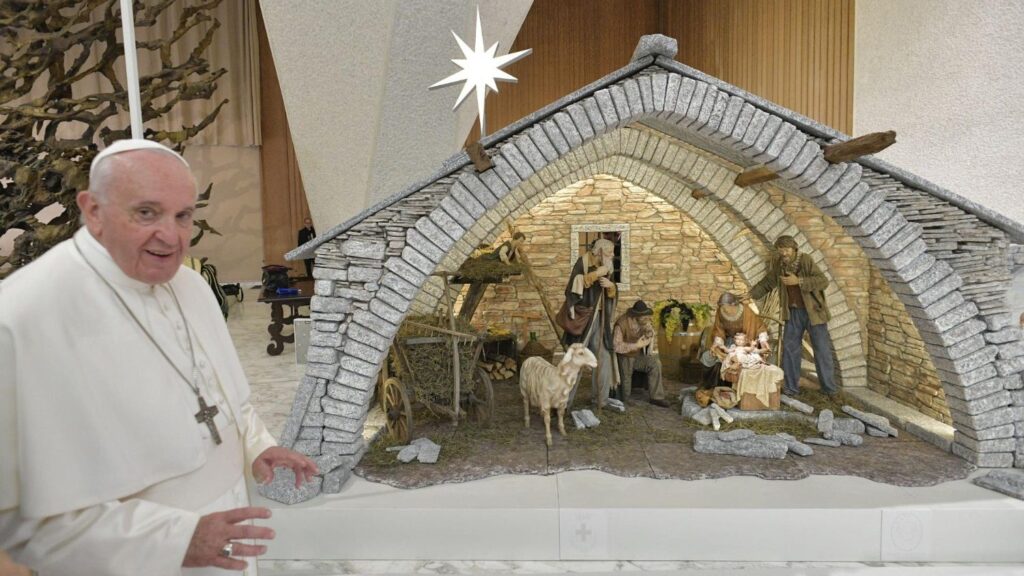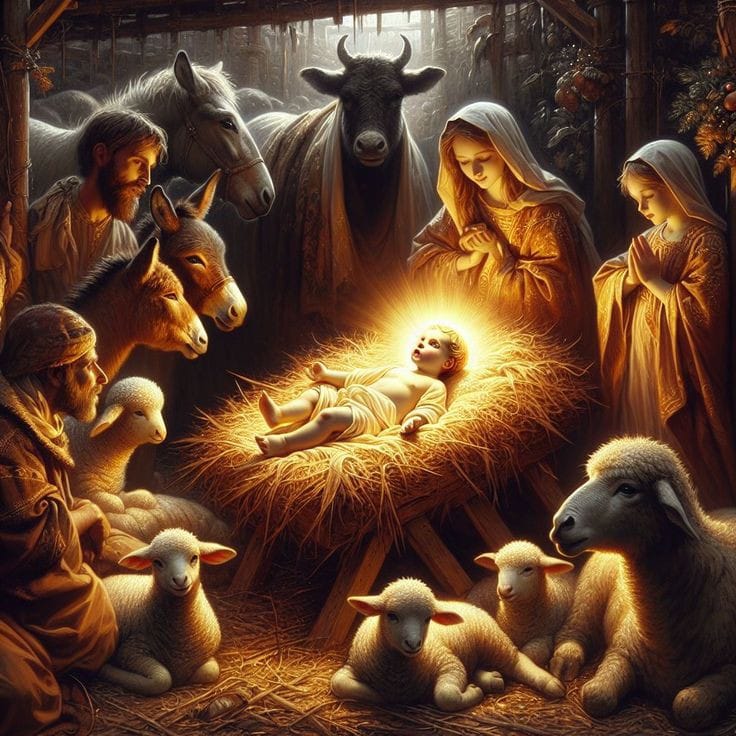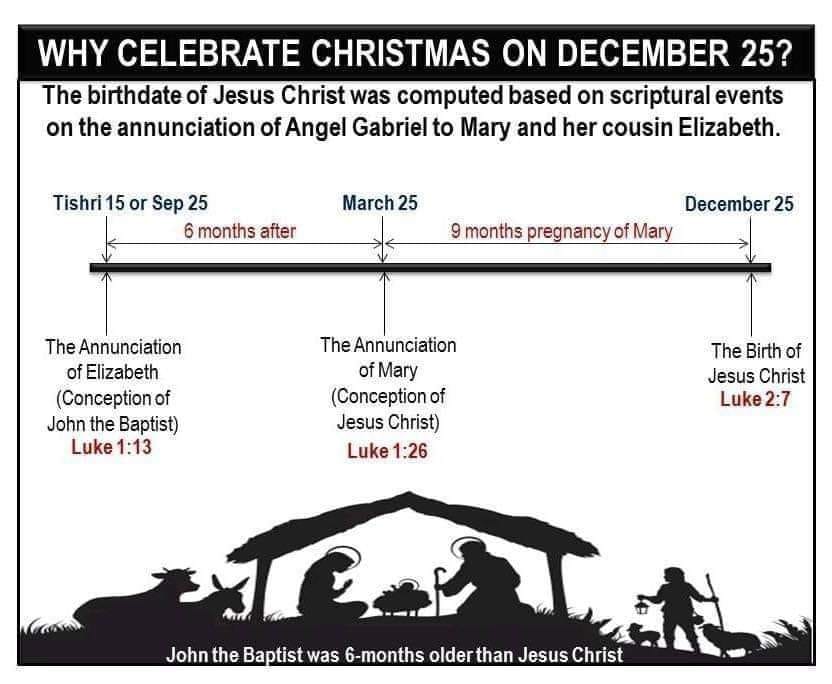Stella Lacson
Most people usually accept history and records the date of births of Pluto (428-348 B.C.), Socrates (471-399 B.C.), and Julius Caesar (100-44 B.C.) as examples, but when it comes to Jesus Christ, the most important name in history that split time from B.C. to A.D., many of them just can’t accept His date of birth.
It is true that the Bible do not give a clear date within it’s pages, but what about the Tradition of the Church, that history handed down?

We believe that Jesus as a historical figure is every bit as important as Pluto, Socrates, and Caesar, actually, Jesus is infinitely far more important.
The Catholic Church knows when Jesus was born late in December, because it is the Church built in the first century, in contrary to these newly emerged sects. The church even knows when John the Baptist was born.
We can establish the birthday of Christ from Sacred Scripture in two steps. The first step is to use Scripture to determine the birthday of Saint John the Baptist. The next step is using Saint John the Baptist’s birthday as the key for finding Christ’s birthday. We can discover that Christ was born in late December by observing first the time of year in which Saint Luke describes Zacharias in the temple. This provides us with the approximate conception date of John the Baptist. From there we can follow the chronology that Luke gives, and that lands us at the end of December.
St. Luke reports that Zacharias served in the “course of Abias” (Lk 1:5) which Scripture records as the eighth course among the twenty-four priestly courses (Neh 12:17). Each shift of priests served one week in the temple for two times each year. The course of Abias served during the eighth week and the thirty-second week in the annual cycle. However, when did the cycle of courses begin?
Scholars had convincingly established that the first priestly course of Jojarib was on duty during the destruction of Jerusalem on the ninth day of the Jewish month of Av. Thus, the priestly course of Jojarib was on duty during the second week of Av. Consequently, the priestly course of Abias (the course of Saint Zacharias) was undoubtedly serving during the second week of the Jewish month of Tishri—the very week of the Day of Atonement on the month of Tishri. In our Gregorian calendar, the Day of Atonement would land on last week of September.
Zacharias and Elizabeth conceived John the Baptist immediately after Zacharias served his course. This entails that John the Baptist would have been conceived somewhere around the end of September, placing John’s birth at the end of June, confirming the Catholic Church’s celebration of the Nativity of Saint John the Baptist on June 24.
The second-century Protoevangelium of Saint James also confirms a late September conception of John the Baptist since the work depicts Zacharias as High Priest and as entering the Holy of Holies—not merely the holy place with the altar of incense. The Protoevangelium regards Zacharias as a high priest and this associates him with the Day of Atonement, which lands on the tenth day of the Hebrew month of Tishri (roughly the end of our September). Immediately after this entry into the temple and message of the Archangel Gabriel, Zacharias and Elizabeth conceive John the Baptist. Allowing for forty weeks of gestation, this places the birth of John the Baptist at the end of June—once again confirming the Catholic date for the Nativity of Saint John the Baptist on June 24.

The rest of the dating is rather simple. We read that just after the Immaculate Virgin Mary conceived Christ, she went to visit her cousin Elizabeth who was six months pregnant with John the Baptist. This means that John the Baptist was six months older that our Lord Jesus Christ (Lk 1:24-27, 36). If you add six months to June 24 you get December 24-25 as the birthday of Christ. Then, if you subtract nine months from December 25 you get that the Annunciation was March 25. All the dates match up perfectly. So then, if John the Baptist was conceived shortly after the Jewish Day of the Atonement, then the traditional Catholic dates are essentially correct. The birth of Christ would be about or on December 25.
Sacred Tradition also confirms December 25 as the birthday of the Son of God. The source of this ancient tradition is the Blessed Virgin Mary herself. Ask any mother about the birth of her children. She will not only give you the date of the birth, but she will be able to rattle off the time, the location, the weather, the weight of the baby, the length of the baby, and a number of other details. Mothers never forget the details surrounding the births of their babies.
Would the Apostles be interested in hearing Mary tell the story? Of course they would. Do you think the holy Apostle who wrote, “And the Word was made flesh,” was not interested in the minute details of His birth? Even when I walk around with our seven-month-old son, people always ask “How old is he?” or “When was he born?” Don’t you think people asked this question of Mary?
So the exact birth date (December 25) and the time (midnight) would have been known in the first century. Moreover, the Apostles would have asked about it and would have, no doubt, commemorated the blessed event that both Saint Matthew and Saint Luke chronicle for us. In summary, it is completely reasonable to state that the early Christians both knew and commemorated the birth of Christ. Their source would have been His Immaculate Mother.
Further testimony reveals that the Church Fathers claimed December 25 as the Birthday of Christ prior to the conversion of Constantine and the Roman Empire. The earliest record of this is that Pope Saint Telesphorus (reigned A.D. 126-137) instituted the tradition of Midnight Mass on Christmas Eve. Although the Liber Pontificalis does not give us the date of Christmas, it assumes that the Pope was already celebrating Christmas and that a Mass at midnight was added. During this time, we also read the following words of Theophilus (A.D. 115-181), Catholic bishop of Caesarea in Palestine: ![]()
“We ought to celebrate the birthday of Our Lord on what day soever the 25th of December shall happen.”
Shortly thereafter in the second century, Saint Hippolytus (A.D. 170-240) wrote in passing that the birth of Christ occurred on December 25: ![]()
“The First Advent of our Lord in the flesh occurred when He was born in Bethlehem, was December 25th, a Wednesday, while Augustus was in his forty-second year, which is five thousand and five hundred years from Adam. He suffered in the thirty-third year, March 25th, Friday, the eighteenth year of Tiberius Caesar, while Rufus and Roubellion were Consuls.”
Also note in the quote above the special significance of March 25, which marks the death of Christ (March 25 was assumed to corresponded to the Hebrew month Nisan 14 – the traditional date of crucifixion). Christ, as the perfect man, was believed to have been conceived and died on the same day—March 25. In his Chronicon, Saint Hippolytus states that the earth was created on March 25, 5500 B.C. Thus, March 25 was identified by the Church Fathers as the Creation date of the universe, as the date of the Annunciation and Incarnation of Christ, and also as the date of the Death of Christ our Savior.
In the Syrian Church, March 25 or the Feast of the Annunciation was seen as one of the most important feasts of the entire year. It denoted the day that God took up his abode in the womb of the Virgin. In fact, if the Annunciation and Good Friday came into conflict on the calendar, the Annunciation trumped it, so important was the day in Syrian tradition. It goes without saying that the Syrian Church preserved some of the most ancient Christian traditions and had a sweet and profound devotion for Mary and the Incarnation of Christ.
Now then, March 25 was enshrined in the early Christian tradition, and from this date it is easy to discern the date of Christ’s birth. March 25 (Christ conceived by the Holy Ghost) plus nine months brings us to December 25 (the birth of Christ at Bethlehem).
Saint Augustine confirms this tradition of March 25 as the Messianic conception and December 25 as His birth:![]()

“For Christ is believed to have been conceived on the 25th of March, upon which day also he suffered; so the womb of the Virgin, in which he was conceived, where no one of mortals was begotten, corresponds to the new grave in which he was buried, wherein was never man laid, neither before him nor since. But he was born, according to tradition, upon December the 25th.”
In about A.D. 400, Saint Augustine also noted how the schismatic Donatists celebrated December 25 as the birth of Christ, but that the schismatics refused to celebrate Epiphany on January 6, since they regarded Epiphany as a new feast without a basis in Apostolic Tradition. The Donatist schism originated in A.D. 311 which may indicate that the Latin Church was celebrating a December 25 Christmas (but not a January 6 Epiphany) before A.D. 311. Whichever is the case, the liturgical celebration of Christ’s birth was commemorated in Rome on December 25 long before Christianity became legalized and long before our earliest record of a pagan feast for the birthday of the “Unconquered Sun”.
DEC 25 IS THE FEAST OF PAGAN GOD “SOL INVICTUS”?
Most of the anti-Catholic cults favorite allegation is that December 25 is of pagan roots and not really Jesus’ birth. They based it from some limited references quoted from unreliable history books.
As a matter of fact, long before the paganic declaration for the feast of the unconquered Sun (Sol Invictus) the (December 25) is already a belief of the early Christians as Christ’s birth.
First thing we should know “WHEN” does paganic feast declared? Here let us have some references…
“ Sol Invictus (“Unconquered Sun”) was the official sun god of the later Roman Empire and a patron of soldiers. In 274 AD the Roman emperor Aurelian made it an official cult alongside the traditional Roman cults.” (Source: Wikipedia – Sol Invictus)
See? It is clear, (274 AD) is the year that pagan feast for the sun god was declared, called Sol Invictus. On the other hand, the belief of Jesus birth in (December 25) is much earlier than paganic feast Sol Invictus.
SNOWY IN BETHLEHEM DURING DECEMBER?
Non-Catholics argue that it is imposible for Jesus Christ to be born in December since it is winter season. They failed to realize that Israel is located in the Middle East. The winter in Middle East is not the same as the winter in Europe or Northern America. Not all winter seasons in Israel had a snowy weather. It is very rare that snow would fall in Bethlehem during Christmas.
You can verify it in weather websites in the internet and search for the actual climate in Bethlehem during December. In fact, the average temperature in Bethlehem during December is only 10 Deg.C (almost the same temp. in Baguio City, Philippines).
To those who still insists that it is snowy in Bethlehem during Christmas, why not visit there this coming December? Did you know that every December 25, catholics there in the Church of Nativity (Bethlehem) will celebrate Christmas without noticing any snow? So many Catholic pilgrims visiting there during December, and they did not complain for snowy climate, but only for cold weather.
THE CELEBRATION IS MORE IMPORTANT THAN THE DATE
December 25 is not Catholic Church doctrine, nor written in the catechism of the Catholic Church. It is just a belief that came from tradition and computed chronological events in the bible.
Just because, the church do not ignore the fact that the actual date of Jesus may fall between 25, which is either 23, 24 or 26, 27. Thus, Catholic Church do not officially proclaim it as church doctrine, but a mere traditional belief that came from ancient Christians.
Hence, this belief comes out from scriptural theory, by computing chronological events in the bible which made more closer view to (December 25) as Jesus’ birth. What’s most important to Catholics is the celebration of the birth of our Lord and Saviour, and not the date itself.
Date is nothing more important than the celebration itself. You might be born on a leap year (Feb 29), yet you still want to celebrate your birthday on the following year either on Feb 28 or March 1, which does not fall on the actual date of Feb 29. Because what matters most is the celebration that you have added 1 more year of your age. Likewise, Dec 25 might not be the accurate date of Christ’s birth, but it will not matter for Christians since we only want to commemorate the birth of saviour Jesus Christ.
For these reasons, it is reasonable and right to hold that Christ was born on December 25 in 1 B.C. and that he died and rose again in March of A.D. 33. Though, there might be slight inaccuracies with the above computation, but what matters most is the celebration (not the day). The Bible even told a story on which the Feast of Passover was celebrated not on Nisan, but in another month. Because the celebration is what matters most, not the month or day.
For us Catholics, it would be fascinating if it turned out that Christ was indeed born on December 25, but it would not upset us if it turned out that He wasn’t. Because we celebrate the first coming of Christ, not the day. Ironically, many of these hypocrite non-Catholics are enjoying these Christmas holidays and even receive Christmas bonuses.
DECEMBER 25 IS CHRISTMAS ?
The date of the celebration of Christmas is attested by the Church Fathers. The earliest written account that explicitly mentions the birth of Jesus occurring on December 25th comes to us from St. Hippolytus of Rome (170-235 A.D.):
“For the first advent of our Lord in the flesh, when he was born in Bethlehem, was December 25th, a Wednesday, while Augustus was in his forty-second year, but from Adam, five thousand and five hundred years.”
Pope St. Telesphorus (c. 125-136 A.D.), the seventh bishop of Rome, added the midnight Mass to the liturgies already taking place on December 25th in order to honor the precise hour of the day on which it was already believed that Jesus Christ was born into the world.
Theophilus (115-181 A.D.), the Bishop of Caesarea in Palestine, which was a predominant See in the first centuries of Christianity, leaves us the record that, “We ought to celebrate the birthday of Our Lord on what day soever the 25th of December shall happen.”
All of these early witnesses are prior to Christianity moving out of the catacombs and becoming legalized across the Roman Empire with the Edict of Milan in 313 A.D. The date was then finalized for the universal Church by Pope Julius I in 350 A.D.
It’s important to remember that just as the early Christians desired to honor the events in the life of Jesus as closely as possible to the exact spot where they actually happened , they also wanted to honor as closely as possible the precise dates on which they actually occurred. This was their sacred religion, and Jesus their God, for whom they were being mercilessly tortured and killed. Locations and dates were, as they are today, of the utmost importance, because Christianity is fundamentally an incarnational—in the human flesh—religion.
Furthermore, as Dr. Taylor Marshall explains in his very detailed and interesting Defense of the Traditional Date for Christmas, the pagan celebration of the winter solstice (December 21-22) started and finished prior to December 25th, and the cult of the Roman sun god was propagated at least a century after the earliest written account we have of Christmas being celebrated on the 25th of December. More likely, as Taylor Marshall argues, was it instituted to quell the celebration of the birth of the God of the Christians, and not the other way around.
So, in conclusion, there were no widespread pagan festivities happening on December 25th prior to the celebration of the Christmas feast.
In addition to the early Christian tradition, there is also biblical evidence that points to the accuracy of Jesus being born on December 25th, namely, in the account of the conception of St. John the Baptist.
The Gospel of Luke indicates that the Annunciation of the Archangel Gabriel to the Blessed Virgin Mary occurred six months after the conception of St. John the Baptist, with the date of the conception of St. John the Baptist being deduced from the prescribed time that his father, Zechariah, was serving in the temple when he received his own vision of the Archangel Gabriel. Read a detailed explanation from Dr. Taylor Marshall here.
The date of the Annunciation was celebrated by the Church since ancient times on March 25th, placing Jesus’ birth nine months later in late December, near the time of the winter solstice, i.e. December 25th.
This is the most accurate and probable date that we have, based on Church history, sacred tradition, and biblical scholarship, of the actual date of Jesus’ birth.
And this timing with the stars of heaven is, of course, providential. The universe was made through Jesus Christ, the Son of God (John 1:3), and when the world was at its darkest, the “Sun of Justice” (Malachi 4:2) and the “Light of the World” (John 8:12) dawned—the arrival of the promised Messiah for the salvation of mankind.
The significance is potent. The heavens do indeed tell the glory of God!
Toby Kenobe

